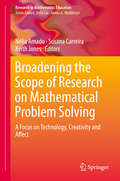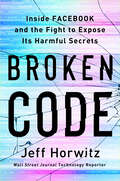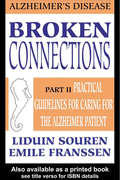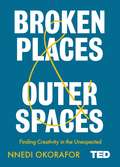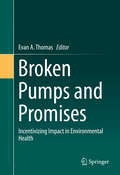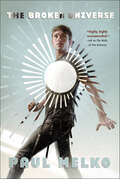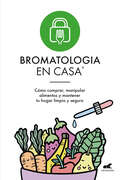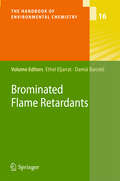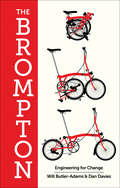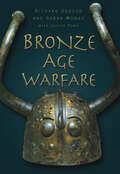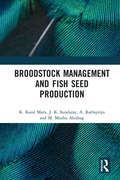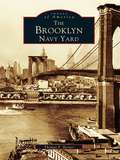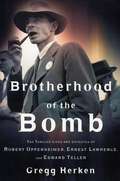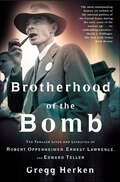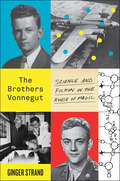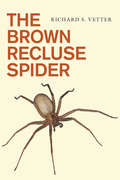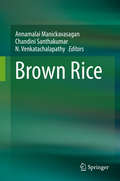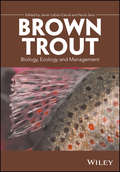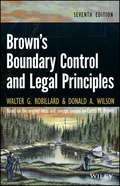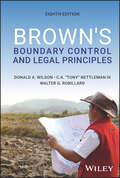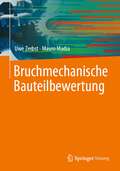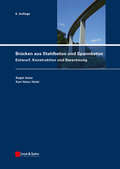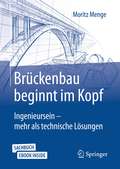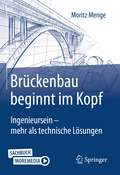- Table View
- List View
Broadening the Scope of Research on Mathematical Problem Solving: A Focus on Technology, Creativity and Affect (Research in Mathematics Education)
by Nélia Amado Susana Carreira Keith JonesThe innovative volume seeks to broaden the scope of research on mathematical problem solving in different educational environments. It brings together contributions not only from leading researchers, but also highlights collaborations with younger researchers to broadly explore mathematical problem-solving across many fields: mathematics education, psychology of education, technology education, mathematics popularization, and more. The volume’s three major themes—technology, creativity, and affect—represent key issues that are crucially embedded in the activity of problem solving in mathematics teaching and learning, both within the school setting and beyond the school. Through the book’s new pedagogical perspectives on these themes, it advances the field of research towards a more comprehensive approach on mathematical problem solving. Broadening the Scope of Research on Mathematical Problem Solving will prove to be a valuable resource for researchers and teachers interested in mathematical problem solving, as well as researchers and teachers interested in technology, creativity, and affect.
Broken Code: Inside Facebook and the Fight to Expose Its Harmful Secrets
by Jeff HorwitzBy an award-winning technology reporter for The Wall Street Journal, a behind-the-scenes look at the manipulative tactics Facebook used to grow its business, how it distorted the way we connect online, and the company insiders who found the courage to speak out"Broken Code fillets Facebook&’s strategic failures to address its part in the spread of disinformation, political fracturing and even genocide. The book is stuffed with eye-popping, sometimes Orwellian statistics and anecdotes that could have come only from the inside." —New York Times Book ReviewOnce the unrivaled titan of social media, Facebook held a singular place in culture and politics. Along with its sister platforms Instagram and WhatsApp, it was a daily destination for billions of users around the world. Inside and outside the company, Facebook extolled its products as bringing people closer together and giving them voice.But in the wake of the 2016 election, even some of the company&’s own senior executives came to consider those claims pollyannaish and simplistic. As a succession of scandals rocked Facebook, they—and the world—had to ask whether the company could control, or even understood, its own platforms.Facebook employees set to work in pursuit of answers. They discovered problems that ran far deeper than politics. Facebook was peddling and amplifying anger, looking the other way at human trafficking, enabling drug cartels and authoritarians, allowing VIP users to break the platform&’s supposedly inviolable rules. They even raised concerns about whether the product was safe for teens. Facebook was distorting behavior in ways no one inside or outside the company understood. Enduring personal trauma and professional setbacks, employees successfully identified the root causes of Facebook's viral harms and drew up concrete plans to address them. But the costs of fixing the platform—often measured in tenths of a percent of user engagement—were higher than Facebook's leadership was willing to pay. With their work consistently delayed, watered down, or stifled, those who best understood Facebook&’s damaging effect on users were left with a choice: to keep silent or go against their employer.Broken Code tells the story of these employees and their explosive discoveries. Expanding on &“The Facebook Files,&” his blockbuster, award-winning series for The Wall Street Journal, reporter Jeff Horwitz lays out in sobering detail not just the architecture of Facebook&’s failures, but what the company knew (and often disregarded) about its societal impact. In 2021, the company would rebrand itself Meta, promoting a techno-utopian wonderland. But as Broken Code shows, the problems spawned around the globe by social media can&’t be resolved by strapping on a headset.
Broken Connections: Alzheimer's Disease: Part II
by Emile Franssen Liduin SourenA manual to providing nursing care during the functional decline of Alzheimer's patients, emphasizing how to evaluate the patients' competence at each stage and allow them to take as much care of themselves as possible.
Broken Places & Outer Spaces: Finding Creativity In The Unexpected (Ted 2 Ser.)
by Nnedi OkoraforNnedi Okorafor was never supposed to be paralyzed. A college track star and budding entomologist, Nnedi’s lifelong battle with scoliosis was just a bump in her plan - something a simple surgery would easily correct. But when Nnedi wakes from the surgery to find she can’t move her legs, her entire sense of who she is begins to waver. Confined to a hospital bed for months, unusual things begin to happen. Psychedelic bugs crawl her hospital walls; strange dreams visit her nightly. She begins to feel as if she’s turning into a cyborg. Unsure if she’ll ever walk again, Nnedi begins to put these experiences into writing, conjuring up strange, fantastical stories. What Nnedi discovers during her confinement would prove to be the key to her life as a successful science fiction writer: In science fiction, when something breaks, something greater often emerges from the cracks. While she may be bedridden, instead of stopping her journey Nnedi’s paralysis opens up new windows in her mind, kindles her creativity and ultimately leads her to become more alive than she ever could have imagined. Nnedi takes the reader on a journey from her hospital bed deep into her memories, from her painful first experiences with racism as a child in Chicago to her powerful visits to her parents’ hometown in Nigeria, where she got her first inkling that science fiction has roots beyond the West. This was not the Africa that Nnedi knew from Western literature - an Africa that she always read was a place left behind. The role of technology in Nigeria opened her eyes to future-looking Africa: cable TV and cell phones in the village, 419 scammers occupying the cybercafés, the small generator connected to her cousin’s desktop computer, everyone quickly adapting to portable tech devices due to unreliable power sources. Nnedi could see that Africa was far from broken, as she’d been taught, and her experience there planted the early seeds of sci-fi - a genre that speculates about technologies, societies, and social issues - from an entirely new lens. In Broken Places & Outer Spaces, Nnedi uses her own experience as a jumping off point to follow the phenomenon of creativity born from hardship. From Frida Kahlo to Mary Shelly, she examines great artists and writers who have pushed through their limitations, using hardship to fuel their work. Through these compelling stories and her own, Nnedi reveals a universal truth: What we perceive as limitations have the potential to become our greatest strengths - far greater than when we were unbroken.
Broken Pumps and Promises: Incentivizing Impact in Environmental Health
by Evan A. ThomasThis volume highlights some of thechallenges in delivering effective environmental health interventions, andpresents examples of emergent theories and case studies that can help close thegap between intent and impact. These include impact crediting systems,objective evidence gathering tools, and social businesses that service environmentalhealth. The case studies presented cross disciplines, scales, organizationaland national boundaries and can defy easy categorization. A water project maybe designed for a health impact, but financed with a climate change tool, andleverage high tech cell phone sensors. A cookstove program may be primarilyconcerned with employment and capacity building, but balance environmental andhealth concerns. Presently, the impact of interventions may notalways be aligned to the intent sought. In this book, readers will discoveralternative ways to move the mindset of funders and implementers towardpay-for-performance models of humanitarian and environmental interventions. Undergraduate and graduate students taking courses in social enterprise, socialentrepreneurship, global health, appropriate technology, internationaldevelopment and development engineering would benefit from these increasinglynon-traditional case studies that challenge commonly accepted presentations ofpoverty reduction and social enterprise.
The Broken Universe (John Rayburn Universe)
by Paul MelkoA thrilling adventure that spans alternate universes, filled with multiple doppelgängers, transdimensional corporate takeovers, and a struggle for survival across the multiverse.Possessing technology that allows him to travel across alternate worlds, John Rayburn begins building a transdimensional commercial empire, led by him, his closest friends, and their doppelgängers from several different parallel universes. But not every version of every person is the same, and their agendas do not always coincide. Despite their benign intentions, the group's activities draw unwanted attention from other dimensional travelers who covet their technology and will kill anyone to control it, a threat that culminates in a nuclear standoff for dominance throughout the multiverse.Sequel to The Walls of the UniverseAt the Publisher's request, this title is being sold without Digital Rights Management Software (DRM) applied.
Bromatología en casa®: Cómo comprar, manipular alimentos y mantener tu hogar limpio y seguro.
by Mariana Al Erica Pitaro Hoffman Daniela CrimerDesde la cuenta de Instagram Bromatología en casa®, Mariana Al, técnica en alimentos, Daniela Crimer, ingeniera agrónoma, y Erica Pitaro Hoffman, ingeniera en alimentos, concientizan e informan sobre prevenir y erradicar infestaciones y la manera correcta de limpiar nuestro hogar y comprar y manipular alimentos. Porque saber es siempre mejor que no saber y, sobre todo, porque #NoPasaHastaquePasa. ¿Es correcto lavar la carne? ¿Y si le pongo limón? ¿Es seguro darles una hamburguesa a los chicos? Si saco la parte con hongos, ¿lo puedo comer? ¿Mezclando detergente y lavandina limpio y desinfecto al mismo tiempo? ¿Dejo la tapita de metal del queso crema? Se me llenó la cocina de cucarachas y mosquitas. No entiendo lo que dice el rótulo de las galletitas. Había olor feo en la pescadería, ¿es normal? ¿Necesito sanitizar la fruta y las verduras?
Brominated Flame Retardants (The Handbook of Environmental Chemistry #16)
by Damià Barceló Ethel EljarratBrominated flame retardants are one of the last classes of halogenated compounds that are still being produced worldwide and used in large quantities in many applications. They are used in plastics, textiles, electronic circuitry, and other materials to prevent fires. This volume covers the state-of-the-art of the analysis, fate and behaviour of brominated flame retardants. Experts in the field provide an overview of the compounds' physico-chemical properties and uses, their occurrence in the environment and biota, advanced chemical analytical methods, degradation studies, toxicological effects and human exposure. This book is a valuable and comprehensive source of information for environmental scientists interested in brominated flame retardant issues, and for authorities and producers.
The Brompton: Engineering For Change
by William Butler-Adams Dan DaviesThe story of how Brompton, the iconic folding bicycle that you can take anywhere—and that can take you anywhere—grew from a small cult bike company to a multimillion-dollar business Lightweight, compact, distinctively styled, and now, electric: The Brompton isn’t the only folding bicycle—or even the first. But everyone who has been on one will enthusiastically testify to its marvelous design (virtually unchanged over decades) and the particular joy of riding it. Will Butler-Adams, CEO of Brompton Bicycles, has been at the company for twenty years. Initially, he worked as an engineer for Andrew Ritchie, the bike’s brilliant inventor and the business’s founder, before taking the helm in 2008. Butler-Adams’s heartfelt mission is to grow and promote sustainable urban transportation and to improve city-dwellers’ lives everywhere. Under his leadership, Brompton has grown from making a few hundred bikes a year to over 90,000, with revenue of $130 million. But progress hasn’t always been easy: There have been boardroom struggles, supply-chain problems, and conflicts with founder Andrew Ritchie. In The Brompton, Butler-Adams brings to life what it means to grow a company to global scale. He also tells the stories of the people who make the Brompton and the people who ride it. And he explains how customers all around the world fell in love with a brand that never set out to be a brand.
Bronze Age Warfare
by Richard Osgood Sarah MonksThe Bronze Age, so named because of the technological advances in metalworking and countless innovations in the manufacture and design of tools and weapons, is among the most fascinating periods in human history. Archaeology has taught us much about the way of life, habits and homes of Bronze Age people, but as yet little has been written about warfare. What was Bronze Age warfare like? How did people fight and against whom? What weapons were used? Did they fortify their settlements, and, if so, were these intended as defensive or offensive structures? in response to these and many other questions, Bronze Age Warfare offers and intriguing insight into warfare and society, life and death in Europe 4000 years ago. It describes the surviving evidence of conflict - fortifications, weapons and body protection, burials, human remains and pictorial evidence - and seeks to understand the role played by aggression in the prehistoric world.
Broodstock Management and Fish Seed Production
by K. Karal Marx J. K. Sundaray A. Rathipriya M. Muthu AbishagThe book entitled “Broodstock Management and Fish Seed Production” provides information relating to commercially cultivable fresh water fishes, broodstock management, fish seed production technology, fish seed quality management including induced breeding with neat illustration. Increasing the aquaculture production can be achieved through the supply of quality fish seed. This book will be immensely helpful to farmers, hatchery managers, entrepreneurs and fisheries graduates pursuing research in the area of freshwater broodstock management and sustainable development of freshwater aquaculture in the country. Note: T& F does not sell or distribute the Hardback in India, Pakistan, Nepal, Bhutan, Bangladesh and Sri Lanka.
Brooklyn Navy Yard, The (Images of America)
by Thomas F. BernerNot much larger than a few city blocks (219 acres,plus 72 acres of water), the Brooklyn Navy Yard isone of the most historically significant sites in America. It was one of the U.S. Navy's major shipbuilding and repair yards from 1801 to 1966. It produced more than 80 warships and hundreds of smaller vessels. At its height during World War II, it worked around the clock, employing some 70,000 people. The yard built the Monitor, the world's first modern warship; the Maine, whose destruction set off the Spanish-American War; the Arizona, whose sinking launched America into World War II; and the Missouri, on whose deck World War II ended. On June 25, 1966, the flag at the Brooklyn Navy Yard was lowered for the last time and the 165-year-old institution ceased to exist. Sold to the City of New York for $22.4 million, the yard became a site for storage of vehicles, some light industry, and a modest amount of civilian ship repair.
Brotherhood of the Bomb: The Tangled Lives and Loyalties of Robert Oppenheimer, Ernest Lawrence and Edward Teller
by Gregg HerkenThe lives and interactions of Lawrence, Oppenheimer and Teller, who invented the atomic bomb.
Brotherhood of the Bomb: The Tangled Lives and Loyalties of Robert Oppenheimer, Ernest Lawrence, and Edward Teller
by Gregg Herken“The scientists who made the nuclear bomb are the focus of this detailed, engrossing history of one of the greatest scientific discoveries of the 20th century.” —Publishers WeeklyThe story of the twentieth century is largely the story of the power of science and technology. Within that story is the incredible tale of the human conflict between Robert Oppenheimer, Ernest Lawrence, and Edward Teller—the scientists most responsible for the advent of weapons of mass destruction.The story of these three men, builders of the atomic and hydrogen bombs, is fundamentally about loyalty—to country, to science, and to each other—and about the wrenching choices that had to be made when these allegiances came into conflict. In Brotherhood of the Bomb, Gregg Herken gives us the behind-the-scenes account based upon a decade of research, interviews, and newly released Freedom of Information Act and Russian documents.
The Brothers Vonnegut: Science and Fiction in the House of Magic
by Ginger StrandWorlds collide in this true story of weather control in the Cold War era and the making of Kurt VonnegutIn the mid-1950s, Kurt Vonnegut takes a job in the PR department at General Electric in Schenectady, where his older brother, Bernard, is a leading scientist in its research lab--or "House of Magic." Kurt has ambitions as a novelist, and Bernard is working on a series of cutting-edge weather-control experiments meant to make deserts bloom and farmers flourish.While Kurt writes zippy press releases, Bernard builds silver-iodide generators and attacks clouds with dry ice. His experiments attract the attention of the government; weather proved a decisive factor in World War II, and if the military can control the clouds, fog, and snow, they can fly more bombing missions. Maybe weather will even be the "New Super Weapon." But when the army takes charge of his cloud-seeding project (dubbed Project Cirrus), Bernard begins to have misgivings about the harmful uses of his inventions, not to mention the evidence that they are causing alarming changes in the atmosphere.In a fascinating cultural history, Ginger Strand chronicles the intersection of these brothers' lives at a time when the possibilities of science seemed infinite. As the Cold War looms, Bernard's struggle for integrity plays out in Kurt's evolving writing style. The Brothers Vonnegut reveals how science's ability to influence the natural world also influenced one of our most inventive novelists.
The Brown Recluse Spider
by Richard S. VetterThe brown recluse is a fascinating spider very well adapted to dwelling in houses and other buildings. Because of this very quality and the ghastly reputation associated with the medical consequences of its bite, it has become infamous throughout North America. Although recluse spiders can cause serious skin injuries and, in very rare cases, death, the danger posed by this spider is often exaggerated as a result of arachnophobia and the misdiagnosis of non-spider-related conditions as brown recluse bites. These misdiagnoses often occur in areas of North America where the spider does not exist, making legitimate bites improbable. One of the greatest factors that keeps the myths alive is misidentification of common (and harmless) spiders as brown recluses. With this book, Richard S. Vetter hopes to educate readers regarding the biology of the spider and medical aspects of its bites, to reduce the incidence of misdiagnoses, and to quell misplaced anxiety. In The Brown Recluse Spider, Vetter covers topics such as taxonomy, identification, misidentification, life history characteristics and biology, medical aspects of envenomations, medical conditions misdiagnosed as brown recluse bites, other spider species of medical consideration (several of which have been wrongly implicated as threats to human health), and the psychology behind the entrenched reasons why people believe so deeply in the presence of the spider in the face of strong, contradictory information. Vetter also makes recommendations for control of the spider for households in areas where the spiders are found and describes other species of recluse spiders in North America. Although The Brown Recluse Spider was written for a general audience, it is also a valuable source of information for arachnologists and medical personnel.
Brown Rice
by Annamalai Manickavasagan Chandini Santhakumar N. VenkatachalapathyThis book provides a broad-based foundation of knowledge about brown rice, including the latest information on health benefits and disease prevention resulting from consumption of brown rice, and information on consumer knowledge, attitudes, and behaviors towards brown rice. It is the first book of its kind to provide a comprehensive review of current brown rice science and technology, regulatory/policy issues, dietary intake, consumer interest and health promotion. The edited volume focuses on the latest developments in breeding varieties for high quality brown rice, varietal variations, defects, milling, cooking quality, eating quality, post-harvest management and methods to improve shelf life. Contributing authors address the physical, chemical, engineering, nutritional and glycemic qualities of brown rice in different chapters. Authors also discuss the physiological functions of brown rice in vivo and radical scavenging activity, emphasizing their impo rtance to growers, technologists and consumers, and providing insight into future advances. This comprehensive collection benefits scientists, nutritionists, dieticians, diabetic educators, and professionals in the food industry. The information covered is valuable for food scientists and technologists working to develop new brown rice products and enhancing the taste, quality, and health profile of brown rice.
Brown Trout: Biology, Ecology and Management
by Nuria Sanz Javier Lobón-CerviáBrown Trout: Biology, Ecology and Management A comprehensive guide to the most current research, history, genetics and ecology of the brown trout including challenging environmental problems The brown trout is an iconic species across its natural European distribution and has been introduced throughout the World. Brown Trout offers a comprehensive review of the scientific information and current research on this major fish species. While the brown trout is the most sought species by anglers, its introduction to various waters around the world is causing serious environmental problems. At the same time, introduction of exogenous brown trout lineages threats conservation of native gene pools of populations in many regions. The authors summarize the important aspects of the brown trout’s life history and ecology and focus on the impact caused by the species. The text explores potential management strategies in order to maintain numerous damaged populations within its natural distributional range and to ameliorate its impacts in exotic environments. The authors include information on a wide-range of topics such as recent updates in population genetics, evolutionary history, reproductive traits and early ontogeny, life history plasticity in anadromous brown trout and life history of the adfluvial brown trout and much more. This vital resource: Contains the latest research on the biology and ecology of brown trout Includes information on phylogeography, genetics, population dynamics and stock management Spotlights the brown trout’s introduction to regions around the world and the serious environmental impacts Offers a comprehensive review of conservation and management techniques Written for salmonid scientists and researchers, fishery and environmental managers, and students of population genetics, ecology and population dynamics, Brown Trout explores the most recent findings on the history, ecology and sustainability of this much-researched species.
BROWNIAN RATCHETS: From Statistical Physics to Bio and Nano-motors
by David Cubero Ferruccio RenzoniIllustrating the development of Brownian ratchets, from their foundations, to their role in the description of life at the molecular scale and in the design of artificial nano-machinery, this text will appeal to both advanced graduates and researchers entering the field. Providing a self-contained introduction to Brownian ratchets, devices which rectify microscopic fluctuations, Part I avoids technicalities and sets out the broad range of physical systems where the concept of ratchets is relevant. Part II supplies a single source for a complete and modern theoretical analysis of ratchets in regimes such as classical vs quantum and stochastic vs deterministic, and in Part III readers are guided through experimental developments in different physical systems, each highlighting a specific unique feature of ratchets. The thorough and systematic approach to the topic ensures that this book provides a complete guide to Brownian ratchets for newcomers and established researchers in physics, biology and biochemistry.
Brown's Boundary Control and Legal Principles
by Walter G. Robillard Donald A. WilsonThe new edition of Brown's Boundary Control and Legal Principles has been updated to reflect ongoing changes in surveying technology and surveying law, notably by adding water boundary expert George Cole as a contributor to revamp information on Riparian and Littorial Boundaries. Additionally, a new appendix has been introduced containing a comprehensive list of surveying books that have been referenced in court cases and legal decisions as persuasive authority over the years. It is indispensable reading for students and practicioners studying for the Fundamentals of Land Surveying licensure exam.
Brown's Boundary Control and Legal Principles
by Donald A. Wilson Charles A. Nettleman III Walter G. RobillardBROWN'S BOUNDARY CONTROL AND LEGAL PRINCIPLES The latest edition of the industry-leading reference to boundary law for property surveying In the newly revised eighth edition of Brown’s Boundary Control and Legal Principles, a team of distinguished surveying professionals delivers an updated and expanded treatment of the latest in surveying technology and surveying caselaw. This classic reference to boundary law principles for property surveying continues to evolve, covering all relevant and necessary information related to the complex area of boundary law. The book offers a wealth of case studies on federal and state rectangular and non-sectionalized land surveys demonstrating real-world examples. It provides numerous illustrations highlighting the concepts discussed within, and is an essential reference tool for professionals and students in the area, providing: A thorough introduction to the foundational principles of boundary surveying and property rights Comprehensive explorations of decision-making in professional boundary surveying Practical discussions of the legal principles governing land surveying, land boundaries, and land rights A holistic combination of law and surveying that’s ideal as a reference tool and as a learning tool Perfect for practicing surveyors and those studying for the Fundamentals of Surveying (FS) licensing exam, Brown’s Boundary Control and Legal Principles will also benefit undergraduate and graduate students of surveying programs, as well as lawyers who practice in the areas of real estate, land, and property law.
Bruchmechanische Bauteilbewertung
by Uwe Zerbst Mauro MadiaDie sichere Auslegung von Bauteilen kommt an der Anwendung bruchmechanischer Methoden heute nicht mehr vorbei. Das vorliegende Buch bietet eine Einführung in diese Methoden mit besonderen Schwerpunkten auf dem aktuellen Stand der bruchmechanischen Kennwertermittlung und den Methoden der analytischen bruchmechanischen Bauteilbewertung. Es beschreibt die Mechanismen von Risswachstum und Bruch, die grundlegenden Konzepte der Bruchmechanik, die analytische Ermittlung der Rissspitzenbelastung in Bauteilen sowie die Anwendung der Bruchmechanik in unterschiedlichen Kontexten. Der Schwerpunkt liegt dabei auf der praktischen Anwendung u. a. anhand von Demonstrationsbeispielen, die im Detail nachvollzogen werden können.
Brücken aus Stahlbeton und Spannbeton: Entwurf, Konstruktion und Berechnung
by Ralph Holst Karl Heinz HolstDieses Buch gibt einen umfassenden Überblick über den Stahlbeton- und Spannbetonbrückenbau. Die Berechnungs- und Planungsgrundlagen für Straßen- und Eisenbahnbrücken werden dargestellt, die einzelnen Bauwerksteile detailliert beschrieben sowie typische Bauvorgänge erklärt. Bemessung und Konstruktion werden sowohl theoretisch als auch anhand zahlreicher Beispiele dargelegt. Ein umfangreiches Kapitel ist dem Thema Lehrgerüste gewidmet. Für die 6. Aufl age wurde dieses Standardwerk erweitert und aktualisiert. Es berücksichtigt die eingeführten Fassungen der Eurocodes mit den jeweiligen Nationalen Anhängen für Deutschland, die neue Ril 804 der Bahn sowie die neuen europäischen Lagernormen der DIN EN 1337-Reihe. Das Werk ist sowohl eine strukturierte Einführung für den Berufseinsteiger als auch ein übersichtliches Nachschlagewerk für den erfahrenen Praktiker.
Brückenbau beginnt im Kopf: Ingenieursein - mehr als technische Lösungen
by Moritz MengeBauingenieur zu sein ist ein erfüllender Beruf. Bauingenieure gestalten nachhaltige Infrastruktur. Wir errichten Häuser, Straßen, Brücken, Tunnel, Kulturstätten, Türme und vieles mehr. Dafür bringen wir häufig die ganze Ingenieurskunst auf, um solide Lösungen zu erreichen. Und häufig noch mehr, was jenseits der technischen Ingenieurskunst liegt. Das Buch schaut über die technischen Lösungen hinaus in das weitere Umfeld des Bauingenieurs und reflektiert seinen Beruf und die eigene Einstellung aus unterschiedlichsten Perspektiven. „Brückenbau beginnt im Kopf“ bedeutet, sich darauf einzulassen, Verbindungen zu suchen – zu einem ganzheitlichen Berufsbild und seinem Standort als Ingenieur. Wenn der sichere Brückenschlag zum Umfeld des Ingenieurs gelingt, heißt Ingenieursein mehr als perfekte Technik anzuwenden.
Brückenbau beginnt im Kopf: Ingenieursein - mehr als technische Lösungen
by Moritz MengeBauingenieur zu sein ist ein erfüllender Beruf. Bauingenieure gestalten nachhaltige Infrastruktur. Wir errichten Häuser, Straßen, Brücken, Tunnel, Kulturstätten, Türme und vieles mehr. Dafür bringen wir häufig die ganze Ingenieurskunst auf, um solide Lösungen zu erreichen. Und häufig noch mehr, was jenseits der technischen Ingenieurskunst liegt. Das Buch schaut über die technischen Lösungen hinaus in das weitere Umfeld des Bauingenieurs und reflektiert seinen Beruf und die eigene Einstellung aus unterschiedlichsten Perspektiven. „Brückenbau beginnt im Kopf“ bedeutet, sich darauf einzulassen, Verbindungen zu suchen – zu einem ganzheitlichen Berufsbild und seinem Standort als Ingenieur. Wenn der sichere Brückenschlag zum Umfeld des Ingenieurs gelingt, heißt Ingenieursein mehr als perfekte Technik anzuwenden.
